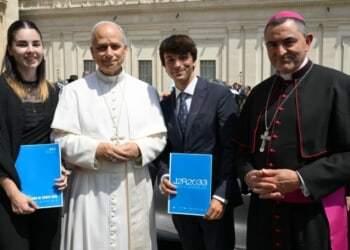Ross Hutton is Vice-Chair of Campaigns for the Glasgow Conservative Association.
“But above the grey land and the spasms of bleak dust which drift endlessly over it, you perceive, after a moment, the eyes of Doctor T. J. Eckleburg. The eyes of Doctor T. J. Eckleburg are blue and gigantic—their retinas are one yard high. They look out of no face, but, instead, from a pair of enormous yellow spectacles which pass over a non-existent nose. Evidently some wag of an oculist set them there to fatten his practice in the borough of Queens, and then sank down himself into eternal blindness, or forgot them and moved away.” F. Scott Fitzgerald The Great Gatsby
I was reminded of this passage on numerous occasions during the Hamilton, Larkhall and Stonehouse By-Election Campaign. Upon entering Larkhall by train and leaving its station, you would be greeted by the eyes of not of Fitzgerald’s forgotten oculist, but by those of Nigel Farage. His billboard showed him as broad, beaming, almost omnipresent. This entire campaign was fought both under his gaze and in his shadow.
As any English student worth their salt could tell you, that is the rhetorical brilliance of Doctor Eckleburg; He is always there, always watching, even when he isn’t. Farage was in every conversation, even when he wasn’t mentioned. He chapped every door, despite never knocking. He cast every vote, despite never putting a cross in a box.
It was the national invading on the local, following in the footsteps of so many By-Elections. In the post-match analysis, Labour’s victory is being chalked up as a win for local, pavement politics over great causes. I’m not entirely sure how true that is.
John Swinney was happy to make his great cause of the campaign a battle between two forms of populism: “Choose your fighter, good people of Hamilton, Larkhall and Stonehouse. it’s me vs Farage”. Farage and his local candidate Ross Lambie, for their part, were happy to oblige, exemplified by Lambie’s TV debate with the SNP candidate Katy Loudon days before the poll. Their great cause of painting the “traditional” parties as being timid, behind the times and banal feels well-versed at this point but was no-less potent.
Anas Sarwar was not without his own great cause, as he got embroiled in a back and forth with Reform following their attack ad showing a speech that he had given to South Asian community leaders in 2022. The Labour great cause then became about painting Farage as a racist, which took precedent over their initial great cause of keeping their candidate Davy Russell away from literally every and any microphone imaginable.
Make no mistake, this By-Election was a battle of great causes being fought on the battlefield of local issues. Pavements, potholes and town centres are the trenches in which the foot soldiers of the campaign were embroiled in order to win the wider war of great causes.
You may, perhaps, have noticed that I have come this far without yet mentioning The Conservatives. The fact that so much can be said and written about this campaign before you touch on our role within it tells its own story.
One thing that should be cleared up straight away is that they 6 per cent share of the vote was a deeply unfair reflection on The Conservative candidate, Cllr Richard Nelson. Richard Nelson is a brilliant councillor who represents the Larkhall Ward in South Lanarkshire Council, and I was blown away on the doorstep by the level of both name recognition and local positivity for him personally.
Even from members of the public who did not or would not vote Conservative, there was a constant recognition of the work he does for the community within his role. If this were truly a campaign fought and won on local issues, then the result would have looked rather different indeed. If we take as read then that there was no question over the strength of the local cause, it leads us to a greater, bigger question. What was our great cause and what will our great cause be going forward?
Because, you see, the great causes that were sampled by the SNP, Reform and Labour in this byelection can and will continue into the 2026 Holyrood elections. But what of The Conservatives? For over a decade, our great cause has been self-evident – Vote Tory, Get Union. The short-term, electoral success of such a cause cannot be questioned, but the long-term sustainability of that messaging certainly can be. The virility of the anti-Independence message relies on there actually being a pro-independent message from someone else. With Independence playing virtually no role at all in this campaign, there was no role for an anti-independence message. With no role for an antiindependence message, there was seemingly no role for The Conservatives.
While the other parties articulated their great cause, we articulated our once-great cause.
This isn’t a criticism of Russell Findlay, or the wider leadership team within Scotland. Findlay is an energetic and charismatic leader whom I do believe is trying to move the Scottish Conservatives into a position of being able to offer more than just a vote against Independence. Nor am I saying that we need not make the case for the Union any longer and that the nationalist threat has gone forever – it hasn’t, and the Union must be continually argued for in the strongest possible terms. However, we remain in a rut of finding it much easier to define what we are against, rather than what we are for. It will take time to change our identity. That time must be granted, but change it must.
There is no shortage of opportunities when it comes to how this can be achieved.
The politics of the 2030s will be unrecognisable to the politics of the 2010s and 2020s. The advent of AI and its mass application is going to bring about a second Industrial Revolution. The workforce of the next decade will look almost unrecognisable and the impact that this will have on the state is almost unthinkable. Scotland currently suffers from a crippling tax burden, a culture of welfarism and a state that serves only to exacerbate both problems. In short, the country is not only not ready to meet the challenges of the 2030s, but the Holyrood bubble appears to be in complete denial that those challenges will even exist. None of the great causes put forward by the parties in Hamilton, Larkhall and Stonehouse have done anything to address these issues or even acknowledge their existence.
In the face of a tsunami, our politicians are offering a pair of wellington boots and an umbrella.
The next decade will require answers for questions we can barely dream of right now, but there is no surprise that one of the countries already benefiting the most from this revolution is Singapore. This is the single greatest model country for Scotland to replicate, as set out in detail in the brilliant paper that was published in April this year by Oxford Economics and Sir Tom Hunter. Singapore is currently the antithesis of Scotland; low tax, pro-business, high trust, low welfare and a healthcare system that is driven by the market. It is everything we’re not, but it’s everything we could be.
One looks at that island nation and thinks “Lord, I have seen what you have done for others…”, however, this is the great cause which we as Conservatives can champion. I have written previously regarding the possibility of building a new Conservative Movement in Scotland, and public opinion is moving to the right north of the border.
The Scottish national revival can and should be synonymous with the revival of Scottish Conservatism, which starts this coming weekend in Edinburgh at the Scottish Conservative Party Conference.
F. Scott Fitzgerald once said that “No grand idea was ever born in a conference, but a lot of foolish ideas have died there”.
At this conference, let the idea that we can win wars fighting yesterday’s battles be the one to pass away, leaving the battlefield free for the new great cause of the Tories in Scotland – cultural restoration with conservative revolution.


![Former Bravo Star Charged After Violent Assault Using a Rock-Filled Sock in Tennessee Walmart [WATCH]](https://www.right2024.com/wp-content/uploads/2025/07/Former-Bravo-Star-Charged-After-Violent-Assault-Using-a-Rock-Filled-350x250.jpg)



![Karoline Leavitt Levels CNN's Kaitlan Collins and Other Legacy Media Reporters [WATCH]](https://www.right2024.com/wp-content/uploads/2025/07/Karoline-Leavitt-Levels-CNNs-Kaitlan-Collins-and-Other-Legacy-Media-350x250.jpg)
![Man Arrested After Screaming at Senators During Big Beautiful Bill Debate [WATCH]](https://www.right2024.com/wp-content/uploads/2025/06/Man-Arrested-After-Screaming-at-Senators-During-Big-Beautiful-Bill-350x250.jpg)

![Illegal Alien Walked Free After Decapitating Woman, Abusing Corpse for Weeks [WATCH]](https://www.right2024.com/wp-content/uploads/2025/07/1753013138_Illegal-Alien-Walked-Free-After-Decapitating-Woman-Abusing-Corpse-for-350x250.jpg)






